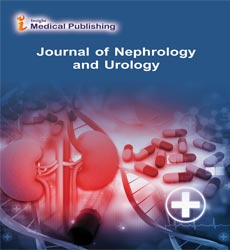Overactive Bladder and Pelvic Organ Mobility
Shun Lina*
Department of Medicine, Renal Division, Peking University First Hospital, Beijing, China
- *Corresponding Author:
- Shun Lina
Department of Medicine, Renal Division, Peking University First Hospital, Beijing, China
E-mail: s.luin21@sjtu.edu.cn
Received date: July 21, 2021; Accepted date: August 04, 2021; Published date: August 11, 2021
Citation: Lina S (2021) Overactive Bladder and Pelvic Organ Mobility. J Nephrol Urol Vol.5 No.S1: 14.
Abstract
Overactive bladder (OAB) is a prevalent condition that deteriorates the quality of life of patients. Bladder has diverse etiologist, which include supra sacral neurological diseases, metabolic syndrome, autonomic dysfunctions and bladder outlet obstruction. In addition a decreased level of estrogenic, bladder outlet incompetence and especially, pelvic organ prolapse are associated with the pathophysiology of female bladder. Overactive bladder is a prevalent condition, which negatively impacts patients’ quality of life. Pelvic organ prolapse also prevalent in women has been recognized as an important ethology of female bladder although the pathophysiological mechanisms remain controversial.
Description
Overactive bladder (OAB) is a prevalent condition that deteriorates the quality of life of patients. Bladder has diverse etiologist, which include supra sacral neurological diseases, metabolic syndrome, autonomic dysfunctions and bladder outlet obstruction. In addition a decreased level of estrogenic, bladder outlet incompetence and especially, pelvic organ prolapse are associated with the pathophysiology of female bladder. Overactive bladder is a prevalent condition, which negatively impacts patients’ quality of life. Pelvic organ prolapse also prevalent in women has been recognized as an important ethology of female bladder although the pathophysiological mechanisms remain controversial.
The dynamic magnetic resonance imaging (DMRI) in 118 patients with pelvic organ prolapse and motilities of a parameters of pelvic organ support and bladder outlet obstruction (urethral kinking) and bladder in order to elucidate the pathophysiology of overactive bladder in patients with pelvic organ prolapse [1].
The results show that compared with non-overactive bladder patients overactive bladder patients had a significantly higher body mass index, more severe pelvic floor muscle impairment and more profound supportive defects in the uterine cervix apical compartment. On the other hand, DMRI parameters shod hardly any significant difference between patients with mild and moderate to severe bladder. These findings may imply that elevator any impairment and defective supports of the apical compartment could be associated with the presence of bladder and the severity of bladder could be affected by factors other than those related to pelvic organ mobility and support or urethral kinking.
Dynamic magnetic resonance imaging was performed in a supine, rather than a standing, position because our magnetic resonance imaging equipment did not allow upright examination. The measure intra-abdominal pressure during the Valsalva manoeuvre. However dynamic magnetic resonance imaging was conducted by one specialized and experienced technician with a consistent protocol and included only patients who are able to reproduce pelvic organ prolapse stage II during straining. The measured pelvic organ mobility with coordinates of selected landmarks at rest and during straining. Strictly speaking, the coordinates at rest would not correspond to the normal positions of the patients [2].
The data on the normal positions because have not performed dynamic magnetic resonance imaging on nulliparous women without any symptoms and a definition of the normal positions on dynamic magnetic resonance imaging of Asian women has not been established. Pelvic organ mobility should be adjusted to the patient’s height or pelvic bone geometry. These corrected methods are not widespread yet it included patients with pelvic organ prolapse stage II at rest and pelvic organ prolapse stage II during straining. There no evaluation the association between mild (stage II during straining) pelvic organ prolapse and bladder of severe pelvic organ prolapse and bladder. MRIs of patients after pelvic organ prolapse repair. There is no result whether decreased pelvic organ mobility after pelvic organ prolapse repair correlated with the improvement of bladder [3].
In conclusion, considering the parameters derived from dynamic magnetic resonance imaging, elevator any impairment and defective supports of the apical compartment associated with the presence of overactive bladder while almost all parameters derived from dynamic magnetic resonance imaging re not associated with the severity of overactive bladder which could be affected by systemic factors.
References
- Khanijow KD, Leri D, Arya LA, Andy UU (2021) A Mobile Application Patient Decision aid for Treatment of Overactive Bladder. Female Pelvic Med Reconstr Sur 27: 365-370.
- Elbaset MA, Taha DE, Sharaf DE, Ashour R, El-Hefnawy AS, et al. (2020) Obesity and overactive bladder: Is it a matter of body weight, fat distribution or function? A preliminary results Urol 143: 91-6.
- Przydacz M, Dudek P, Chlosta P (2020) Prevalence, bother and treatment behavior related to lower urinary tract symptoms and overactive bladder among cardiology patients. J Clin Med 9: 4102.
Open Access Journals
- Aquaculture & Veterinary Science
- Chemistry & Chemical Sciences
- Clinical Sciences
- Engineering
- General Science
- Genetics & Molecular Biology
- Health Care & Nursing
- Immunology & Microbiology
- Materials Science
- Mathematics & Physics
- Medical Sciences
- Neurology & Psychiatry
- Oncology & Cancer Science
- Pharmaceutical Sciences
